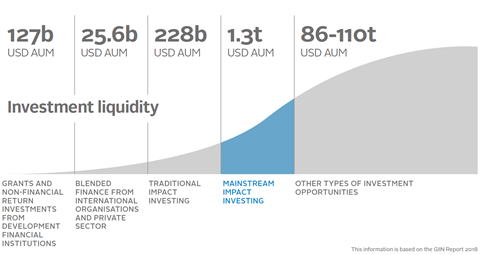While impact investing is a new paradigm for the investment community, there are still many gaps and issues that need to be addressed to take it to the mainstream.
Impact investments and their evolution to the mainstream
The term impact investing, coined by the Rockefeller Foundation 11 years ago, was a disruptive concept for the mainstream investment industry. It represented a new paradigm since it was different from environmental, social and governance (ESG) investing, which focuses on reducing companies’ and investors’ risks and/or assessing companies’ non-financial performance. Instead, impact investing focuses on business models and the products and services these companies produce. In this sense, impact investing aims to positively impact society beyond ESG-related compliance and investing.
Since the emergence of the impact investing concept, the industry has expanded and become incredibly complex. The sector has been boosted by increased attention from policy makers and the development of industry standards, while international organisations such as the UN have promoted impact investing. Bodies such as the council of investors and borrowers that sets the Green Bond Principles have also helped to set common standards.
PRI data shows that about 465 organisations made impact-related investments in 2016, representing US$1.3 trillion in combined AUM – up from 280 and US$800 billion respectively in 2014.
As the impact investing ecosystem grows in size and complexity, traditional impact investing definitions, metrics, business models and investment vehicles need to be re-evaluated. Part of the evolution of this ecosystem involves expanding the scope of the original definition of impact investing to be more flexible and inclusive; in other words, to be more mainstream.
For instance, the traditional impact investing model is usually associated with the theory of change, the concept of additionality and purpose-driven companies. However, the mainstream impact approach focuses on liquid and mature businesses that deliver products or services to benefit society and the environment.
It is important to highlight that mainstream impact investing and traditional or illiquid impact investing exist in the same ecosystem but operate differently. As noted by the World Economic Forum, traditional impact investing targets low and mid-liquidity and maturity impact companies as well as more innovative companies, and can have more disruptive impacts on society and the environment.
Meanwhile, mainstream impact investing targets businesses such as listed equity firms and large privately-owned companies that can have impact at scale and are more attractive to institutional investors and mainstream investors. These two types of impact investments are complementary and work symbiotically.
The figure below provides information on the total assets under management of both types of impact investments and how these compare to social investments and mainstream investing.

The Market Map does not focus on illiquid or early-stage impact investing companies and businesses; rather, it explores opportunities to identify and measure large, mature and liquid companies operating in the impact investing field.
Impact investing and the SDGs
The SDGs are a global effort to pursue an agenda for sustainable economic growth and address social needs including education, health, social protection and job opportunities, while also tackling climate change and other environmental issues. As highlighted by the UN, the SDGs are not legally binding; governments are expected to take ownership and establish national frameworks to achieve the 17 Goals (see below).
A study by the United Nations Conference on Trade and Development (UNCTAD) identified that achieving the SDGs “will take between US$5 to $7 trillion, with an investment gap in developing countries of about $2.5 trillion.” In this scenario, the role of the private sector is critical as it can bring “agility in delivery and new approaches to financing the SDGs”.
Impact investing is one of many approaches the private sector can use to promote and support the implementation of the SDGs. However, it is important to highlight that impact investing is not part of, or intrinsically connected to, the SDGs. For instance, some SDGs target the creation or development of specific country policies, or the implementation of processes (i.e. ESG factors and practices) or governmental strategies.
![]()
Download the full report
-

Impact investing market map
August 2018
Impact investing market map
- 1
- 2
 Currently reading
Currently readingInitial considerations
- 3
- 4
- 5
- 6
- 7
- 8
- 9
- 10
- 11
- 12




















